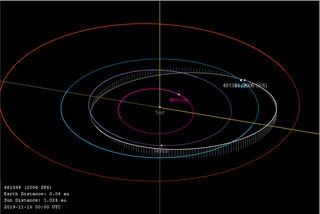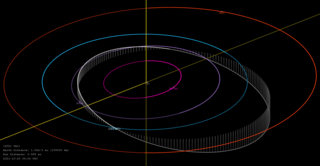Related Research Articles

(276033) 2002 AJ129, provisional designation 2002 AJ129, is a Mercury-crossing asteroid. It has the ninth-smallest perihelion of all numbered asteroids, after asteroids such as 2000 BD19, 2004 UL, and 2008 XM. It makes close approaches to all of the inner planets and asteroid 4 Vesta. The asteroid is estimated to be between 0.5–1.2 kilometers (0.3–0.7 mi) across. In January 2018 there was much media hype about this asteroid being classified as a potentially hazardous asteroid, although there is no known threat of an impact for hundreds if not thousands of years. The media has compared the size of the asteroid to the Burj Khalifa in Dubai.
(101869) 1999 MM is a sub-kilometer asteroid on an eccentric orbit, classified as a near-Earth object and potentially hazardous asteroid of the Apollo group. It was discovered on 20 June 1999, by the Lowell Observatory Near-Earth-Object Search (LONEOS) at its U.S. Anderson Mesa Station in Flagstaff, Arizona. The first observation was made by Catalina Sky Survey just 8 days before its official discovery.
(454101) 2013 BP73, provisional designation 2013 BP73, is a sub-kilometer asteroid, classified as a near-Earth object and potentially hazardous asteroid of the Apollo group, approximately 310 meters (1,020 ft) in diameter.
2011 EO40 is an asteroid, classified as a near-Earth object and a potentially hazardous asteroid of the Apollo group. It is a possible candidate for the parent body of the Chelyabinsk superbolide.
(523662) 2012 MU2, provisional designation 2012 MU2, is a sub-kilometer asteroid on an eccentric orbit, classified as near-Earth object and potentially hazardous asteroid of the Apollo group. It was discovered on 18 June 2012 by astronomers of the Catalina Sky Survey at an apparent magnitude of 19.9 using a 0.68-meter (27 in) Schmidt–Cassegrain telescope. It has an estimated diameter of 240 meters (790 ft). The asteroid was listed on Sentry Risk Table with a Torino Scale rating of 1 on 23 June 2012.
2013 FW13 is an Apollo asteroid and a potentially hazardous object, that was discovered on March 23, 2013 by the Catalina Sky Survey. Further observation of its orbital calculation was made by amateur astronomer Mohammed Alsunni of Sudan.
2009 RR micro-asteroid, classified as near-Earth object of the Apollo group. It was discovered on 11 September 2009 by the Catalina Sky Survey at an apparent magnitude of 19.5 using a 0.68-meter (27 in) Schmidt–Cassegrain telescope. 2009 RR was the only asteroid discovered before 2014 that was predicted to potentially pass inside the orbit of the Moon during 2014. The asteroid has an estimated diameter of 26 meters (85 ft) and is listed on the Sentry Risk Table. It is not large enough to qualify as a potentially hazardous object.
2014 XL7 is a near-Earth object and Apollo asteroid, approximately 230 meters (750 feet) in diameter. It was the most dangerous potentially hazardous asteroid on Sentry Risk Table upon its discovery by the Mount Lemmon Survey in December 2014. At the time, the asteroid had a cumulative 1 in 83000 chance of impacting Earth on 4–5 June between the years 2048 and 2084. After the object's observation arc had been extended to 35 days, it was removed from the Sentry Risk Table on 15 January 2015. Since then the asteroid's orbit has been secured. Although it has an Earth minimum orbit intersection distance of less than one lunar distance, there are no projected close encounters with Earth in the foreseeable future, with its closest passage to occur in May 2046, still millions of kilometers away.
(523775) 2014 YB35, provisional designation 2014 YB35, is a stony near-Earth object and potentially hazardous asteroid of the Apollo group, approximately 300 meters (980 feet) in diameter. It was discovered on 27 December 2014 by the Catalina Sky Survey at the Catalina Station in Arizona, United States. In March 2015, a minor-planet moon, less than half the size of its primary, was discovered by radar astronomers at Goldstone Observatory. The primary body of the binary system has a rotation period of 3.3 hours, while the secondary's orbital period remains unknown.
(456938) 2007 YV56, provisional designation 2007 YV56, is a sub-kilometer asteroid on an eccentric orbit, classified as a near-Earth object and potentially hazardous asteroid of the Apollo group, approximately 190–360 meters (620–1,200 ft) in diameter. It was discovered on 31 December 2007, by astronomers of the Catalina Sky Survey conducted at the Catalina Station in Arizona, United States.
(549948) 2011 WL2 is a sub-kilometer asteroid, classified as a near-Earth object and potentially hazardous asteroid of the Apollo group. It was discovered on 16 November 2011, by astronomers with the LINEAR at the Lincoln Laboratory ETS near Socorro, New Mexico, in the United States.

(415029) 2011 UL21, provisional designation 2011 UL21, is an Apollo class potentially hazardous asteroid discovered on October 17, 2011, by the Catalina Sky Survey project. The asteroid is estimated to have a diameter of 2.5 kilometres (1.6 mi). It was rated at Torino Scale 1 on October 27, 2011, with an observation arc of 9.6 days.

(671294) 2014 JO25 is a near-Earth asteroid. It was discovered in May 2014 by astronomers at the Catalina Sky Survey near Tucson, Arizona - a project of NASA's NEO (Near Earth Object) Observations Program in collaboration with the University of Arizona.
(585310) 2017 YZ1, provisional designation: 2017 YZ1, is a sub-kilometer asteroid on an eccentric orbit, classified as near-Earth object and potentially hazardous asteroid of the Apollo group, approximately 250 meters (800 feet) in diameter. It was first observed on 20 December 2017, by astronomers with the Mount Lemmon Survey at Mount Lemmon Observatory near Tucson, Arizona, in the United States. On 29 January 2018, it passed Earth at 125 lunar distances.

(505657) 2014 SR339, provisional designation 2014 SR339, is a dark and elongated asteroid, classified as near-Earth object and potentially hazardous asteroid of the Apollo group, approximately 970 meters (3,200 feet) in diameter. It was discovered on 30 September 2014, by NASA's Wide-field Infrared Survey Explorer telescope (WISE) in Earth's orbit. Closely observed at Goldstone and Arecibo in February 2018, it has a rotation period of 8.7 hours.
(85182) 1991 AQ is a stony asteroid on a highly eccentric orbit, classified as near-Earth object and potentially hazardous asteroid of the Apollo group, approximately 1.1 kilometers in diameter. It was discovered on 14 January 1991, by American astronomer Eleanor Helin at the Palomar Observatory in California. Based on its brightness variation of 0.69 magnitude, this Q-type asteroid is likely elongated. It belongs to the small group of potentially hazardous asteroids larger than one kilometer.

2010 WC9, unofficially designated ZJ99C60, is a sub-kilometer near-Earth asteroid of the Apollo group, approximately 100 meters (330 feet) in diameter. First observed for eleven days by the Catalina Sky Survey in 2010, the asteroid was recovered in May 2018 during its sub-lunar close encounter with Earth.

(481394) 2006 SF6 is a sub-kilometer near-Earth object and potentially hazardous asteroid of the Aten group, approximately 300 meters (1,000 feet) in diameter. It was discovered on 17 September 2006, by the Catalina Sky Survey at Catalina Station in Arizona. On 21 November 2019, it passed Earth at a distance of 11 lunar distances (0.0288 AU), which is the object's closest flyby for centuries. The stony A/S-type asteroid is highly elongated in shape and has a rotation period of 11.5 hours.

(620094) 2016 AJ193 (provisional designation 2016 AJ193; also known as 2010 KV134) is a near-Earth object and potentially hazardous asteroid of the Apollo group, approximately 1.4 kilometres (0.87 mi) in diameter. It was discovered on 17 May 2010 by the Wide-field Infrared Survey Explorer (WISE) satellite, but was lost until it was reobserved on 16 January 2016. With an observation arc over 11 years, 2016 AJ193 has a well-determined orbit and trajectory through the year 2086. The asteroid's orbit is only potentially hazardous on a time scale of thousands of years.

2021 UA1 is a small (~2 meter) near-Earth object that passed about 3047 km from the surface of Earth while passing over Antarctica on 25 October 2021 around 03:07 UT. Given the small size of the asteroid it only reached the brightness of Pluto at around apparent magnitude 14. Since it approached from the direction of the Sun, it was not discovered until 4 hours after closest approach.
References
- 1 2 3 4 "529366 (2009 WM1)". Minor Planet Center. Retrieved 29 May 2019.
- ↑ "MPEC 2009-W30 : 2009 WM1". IAU Minor Planet Center. 18 November 2009. Retrieved 26 June 2012. (K09W01M)
- 1 2 3 4 5 "JPL Small-Body Database Browser: 529366 (2009 WM1)" (2018-11-13 last obs.). Jet Propulsion Laboratory . Retrieved 29 May 2019.
- 1 2 3 4 "Earth Impact Risk Summary: 2009 WM1". Wayback Machine: NASA/JPL Near-Earth Object Program Office. Archived from the original on 27 November 2009. Retrieved 27 July 2013.
- ↑ "Date/Time Removed". NASA/JPL Near-Earth Object Program Office. Archived from the original on 2 June 2002. Retrieved 2 September 2013.
- ↑ "MPC/MPO/MPS Archive". Minor Planet Center. Retrieved 29 May 2019.
- 1 2 3 "JPL Close-Approach Data: (2009 WM1)" (2013-07-06). Retrieved 31 January 2013.
- 1 2 "2009WM1 Ephemerides for 1 May 2014 through 15 June 2014". NEODyS (Near Earth Objects – Dynamic Site). Retrieved 1 February 2014.


